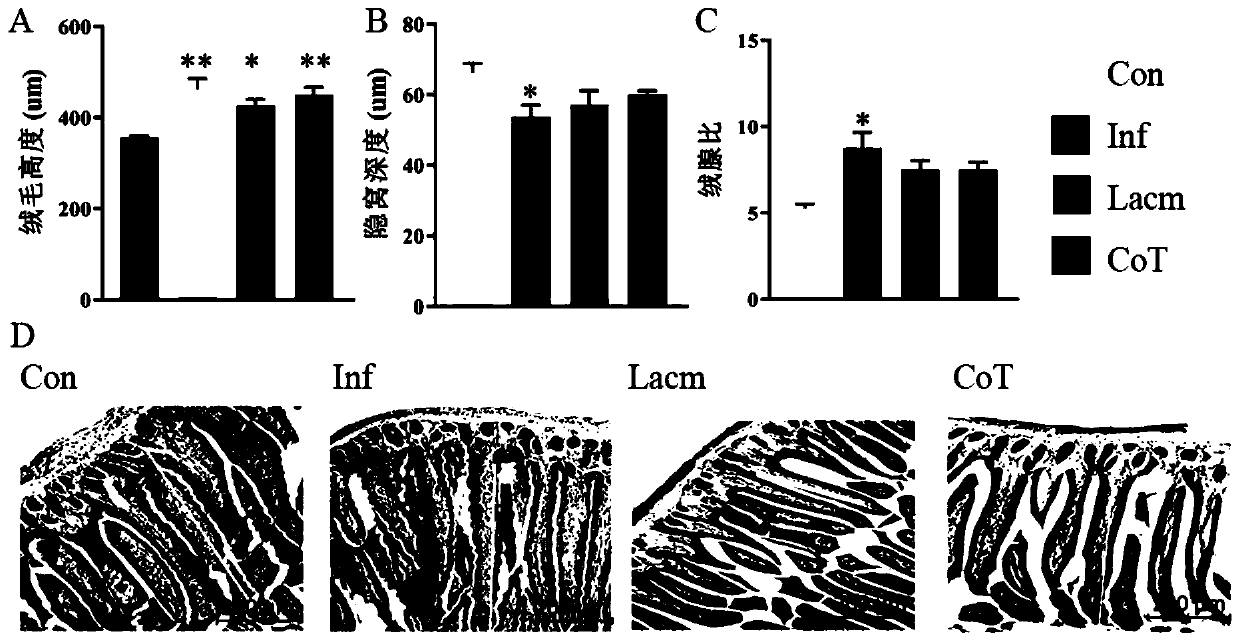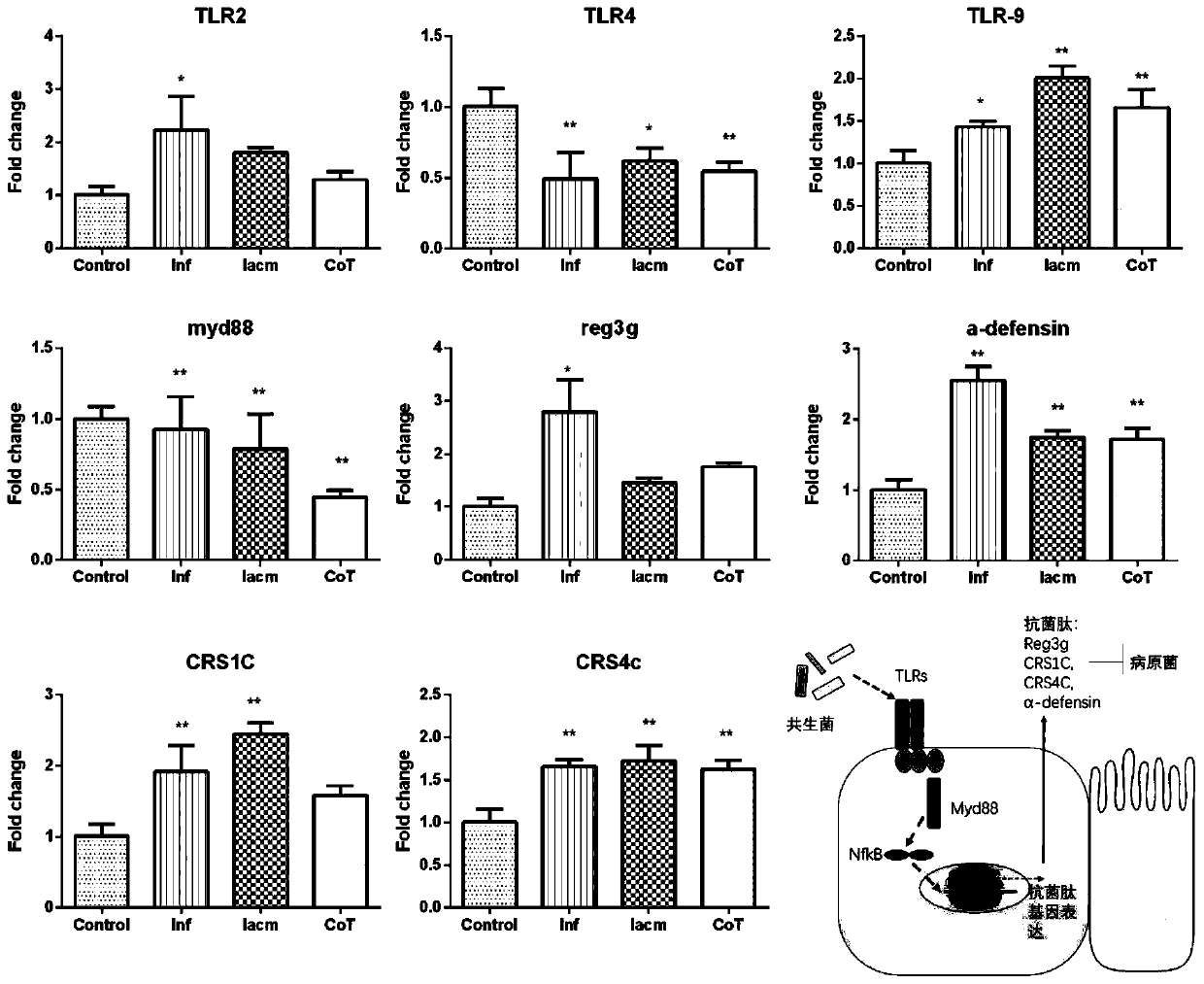Application of lactobacillus reuteri from breast milk to regulation of maternal and infant immune functions
A technology of Lactobacillus reuteri and Lactobacillus reuteri, applied in the direction of Lactobacillus, application, and the function of food ingredients, to achieve the effect of increasing the depth ratio, enhancing immunity, and promoting the production of intestinal antimicrobial peptides
- Summary
- Abstract
- Description
- Claims
- Application Information
AI Technical Summary
Problems solved by technology
Method used
Image
Examples
Embodiment 1
[0048] Example 1: Animal experiment
[0049] 1) Experimental method
[0050] Animal grouping: 40 BALB / C female mice and 14 BALB / C male mice were kept at 8:00-20:00 in the day and night cycle, at a room temperature of 22-24°C, and a humidity of 40-70%, fed with ordinary feed. Separate the male and female to adapt for one week. After one week, they will be caged according to the ratio of female to male = 3:1. After the female is pregnant, the male is taken out. After the female has given birth, the suckling females are divided into two groups, and one group is fed with saline (CON), another group of Lactobacillus reuteri FN041 (1×10 10 CFU / mouse·d), when the pups reach 3 weeks of age, they are weaned naturally, and each group of male pups who have been breast-fed are divided into two groups, and they are fed with normal saline or Lactobacillus reuteri. After 14 days, the treated pups were sacrificed. The above-mentioned mice were grouped into: 1) Con group, both mother and pups wer...
Embodiment 2
[0051] Example 2 Small intestine IgA + Plasma cell immunohistochemical analysis
[0052] (1) Dehydration: Put the small intestine tissues in 50% ethanol; 75% ethanol; 85% ethanol; 90% ethanol for 15 minutes each time, and then put them in 100% ethanol for 30 minutes, and replace the ethanol every 15 minutes.
[0053] (2) Transparent: Prepare a mixture of ethanol and n-butanol at a ratio of 1:1, put the small intestine tissue in the mixture and shake for 20 minutes; discard the liquid, transfer to the n-butanol solution for 40 minutes, and replace the n-butanol every 20 minutes .
[0054] (3) Wax immersion: Immerse in paraffin wax I at 70°C for 3 hours; then transfer to paraffin wax II at 70°C for 3 hours.
[0055] (4) Embedding: Embedding the small intestine tissue processed in step (3) in paraffin.
[0056] (5) Sectioning: Use a Leica microtome to slice 5μm thick jejunum tissue, spread the slices in a water bath at 42℃, and bake slices at 70℃ for 30 minutes.
[0057] (6) Dewaxing and h...
Embodiment 3
[0070] Example 3 Gene expression and antibacterial activity of antimicrobial peptides in small intestinal epithelial cells of young mice:
[0071] The jejunum and small intestine Peyer's knot RNA extraction and cDNA preparation: Take out the liver and spleen of the mouse in the ultra-clean table, cut out 0.1g jejunum and quickly put it into Trizol. The Trizol method was used to extract RNA from jejunum and Peyer's knot. NanoDrop measures OD260 / 280 and concentration, adjusts RNA concentration to 1,000ng / μL, OD 260 / 280 In the range of 1.8-2.0. Perform the reverse transcription of RNA according to the reaction system in Table 1. After mixing the reaction system in the first step, 70℃, 5min, ice bath; after adding the second system and mixing, 37℃ water bath 1h, 95℃, 3min, ice In the bath, the cDNA after reverse transcription is stored at -80°C.
[0072] Jejunal reverse transcription fluorescence quantitative PCR reaction (RT-PCR): Quantitative PCR analysis is performed with jejunal ...
PUM
 Login to View More
Login to View More Abstract
Description
Claims
Application Information
 Login to View More
Login to View More - R&D
- Intellectual Property
- Life Sciences
- Materials
- Tech Scout
- Unparalleled Data Quality
- Higher Quality Content
- 60% Fewer Hallucinations
Browse by: Latest US Patents, China's latest patents, Technical Efficacy Thesaurus, Application Domain, Technology Topic, Popular Technical Reports.
© 2025 PatSnap. All rights reserved.Legal|Privacy policy|Modern Slavery Act Transparency Statement|Sitemap|About US| Contact US: help@patsnap.com



